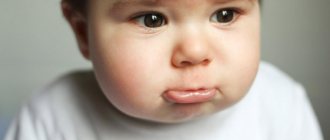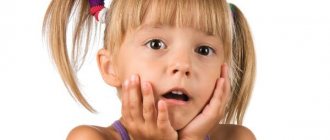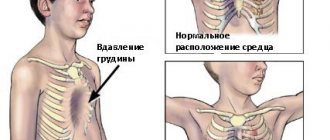The baby has just been making you happy with his smile, when suddenly he starts crying and the newborn’s lower lip is shaking? Do not panic, this condition is natural for a baby and is explained by the immaturity of its nervous and endocrine systems. In healthy children, the lower lip may twitch when crying, frightened, or abrupt awakening.
Trembling of the lower lip and chin in a newborn - normal or pathological?
In medical terminology, trembling of the lower lip and chin in a newborn as a result of involuntary muscle contraction is called tremor. Normally, this condition disappears within 3 months, in rare cases up to a year or a year and a half. The child may flinch when crying, waking up, or exposure to irritants from the external environment (light, sound, cold). Pathology is considered:
- the child’s lower lip trembles in a calm state;
- the baby’s lower lip and chin, limbs, and head are trembling;
- In infants, lip tremor occurs too often;
- the child has reached three months of age, and the trembling of the lower lip and chin when crying does not stop, but intensifies as he grows up. For premature infants, the pathology is tremor in children under one and a half years old and older;
- tremor of wide amplitude is a common symptom of neurological diseases.
Detection of at least one of the symptoms in a baby is a reason to contact a pediatric neurologist.
If tremor is accompanied by insomnia, upset bowel movements and abdominal pain, then contact an endocrinologist; most likely the problem is a malfunction of the thyroid gland. Uncontrollable muscle twitching in a baby is possible due to trauma (including birth).
Frequent trembling of the lower lip, chin and jaw, combined with regular regurgitation, anxiety, and insomnia, may indicate symptoms of muscular dystonia.
Pay attention to the baby's conditions in which the arms, legs or chin shake and try to avoid them. If this is not possible (for example, the lower lip begins to twitch when sucking), then at least try to create as calm an environment as possible.
- Why do ulcers appear on the lips and how to eliminate them quickly
- Red lips in a child: causes, treatment methods
- Furuncle on the lip in children and adults: causes, complications, how to treat
Tremor of limbs in infants
The vigilance and anxiety of many mothers sometimes goes through the roof. When young parents notice that for some reason their infant’s chin is shaking, tremors appear in the arms and legs, they are seized with panic. Is there any real reason to worry?
What is tremor
Each person, under certain circumstances, noticed that his limbs were shaking. Most often this happens from strong excitement. As a result of hypothermia, tremors of the arms and legs occur, the lower jaw trembles, and when crying, the chin and lower lip tremble.
Why do infants often have shaking legs and trembling hands? Muscle twitching is the result of excessive stress, overstrain of the nervous system.
Trembling of the arms and legs, head, lower jaw, lips, which begins as a result of external influences (cold) or when crying, is not a pathological condition if it disappears when the external stimulus is eliminated.
As a rule, until the age of three months, the baby’s nervous system is imperfect, as a result of which one can observe how his leg twitches, his arms shake, and when he cries, his chin, lower lip, and jaw often tremble. It should be immediately noted that if these symptoms quickly disappear after the baby has calmed down, then there is no reason to worry.
Head tremors may indicate certain neurological disorders that require appropriate treatment from a neurologist or neurologist.
Causes of tremor in infants:
- Physiological immaturity of the baby’s nervous system.
- Premature pregnancy.
- Complications during childbirth, such as rapid or prolonged labor.
- Complications that arose during pregnancy: uterine hypertonicity, fetal hypoxia, etc.
- The stress that a mother experiences while carrying a child, her experiences, her fears. All this can affect the baby’s vulnerable nervous system.
As a rule, treatment is not required if:
- Tremors of the arms, legs, and chin are observed in the baby until he reaches the age of three months.
- The chin trembles when the baby cries.
When to sound the alarm
Parents of the baby should be alert if:
- The child’s hands and chin are not only shaking, but convulsive trembling of the whole body is also observed.
- Head tremor.
- The child's arms and legs are shaking for no apparent reason.
- The baby's general condition is alarming: he is lethargic, whiny, and sleeps poorly.
- As the child grows up, the tremor of the arms and legs does not go away and becomes more pronounced.
Having noticed these symptoms, you should rush to the doctor, who, after examining the baby, will be able to explain why the tremor is present.
Children grow by leaps and bounds. Every day there are noticeable changes in their development. The baby simply “outgrows” many of the symptoms. The nervous system matures, and, accordingly, tremors, regurgitation and other troubles remain behind.
To save their nerves, parents need to remember that the issue of trembling limbs in a newborn is more likely not a problem if:
- The baby's chin shakes before the age of three months.
- The baby quickly calms down, and the trembling immediately disappears.
- Against the background of trembling of the arms, legs, and chin, there is no disturbance in the general condition of the baby.
- There are no other neurological symptoms.
- The chin and lower lip tremble while crying.
What to do
As a rule, treatment of tremor in children under 3 months is not required, but it is necessary:
- Monitor the baby's condition.
- Analyze what factors cause the child’s hands, chin, lower lip, and jaw to shake.
- Determine the presence or absence of other complications in the baby’s well-being, for example, sleep disturbances, tearfulness, mild excitability, trembling of the limbs and body for no apparent reason, etc.
- Notify the treating pediatrician or family nurse that the baby’s arms or legs are trembling, and demand that the baby be examined by the appropriate specialists.
- Create an atmosphere of calm and goodwill in the house, since the psychological microclimate in the family significantly affects the health of children.
- Massages and warm baths will also be useful, provided that the baby accepts them with pleasure.
Treatment of tremor in infants is carried out by a neurologist. Only an experienced specialist can prescribe the necessary medications, monitor and, if necessary, adjust the baby’s treatment.
But still
When it comes to the development of a baby, it is always better to play it safe once again, because lost time can significantly complicate the treatment of a possible illness.
If a lip or chin shaking when crying does not cause serious concern, then tremors in the legs and arms, which do not go away as the child grows up, should at least alert parents and serve as a reason to consult a specialist. If necessary, appropriate treatment will be prescribed.
Tremor of the limbs has the same causes that cause trembling of the chin and lower lip. The child's legs and arms may tremble with loud noises, sudden awakening, or during strong crying. Sometimes babies startle in their sleep. Movements can be either symmetrical or asymmetrical.
Usually by 4 months the trembling of the arms and legs completely disappears. Tremors in newborns that do not have a neurological cause do not last more than a few seconds. However, if the baby often throws up his arms and trembles his legs even in a calm environment, often cries, eats and sleeps poorly, you need to consult a specialist.
Tremors of the limbs can be caused by the following pathologies:
- disorders of the thyroid gland;
- hypertonicity;
- consequences of fetal hypoxia;
- incorrect structure of the limbs;
- birth injury;
- encephalopathy;
- cerebral hemorrhage;
- intracranial pressure;
- pathologies of the kidneys and adrenal glands;
- hypocalcemia;
- increased blood glucose levels;
- electrolyte disorder;
- damage to the central nervous system.
Treatment for pathological tremor depends on its cause. The main methods of therapy for infants are massage and therapeutic exercises.
imperfection of the nervous and endocrine systems of a small person who recently came into this world from his mother’s womb. With a rather violent manifestation of emotions, which happens often in such a baby, his adrenal glands cannot cope with the large flow of incoming norepinephrine, and the brain is not able to respond to the movements that are produced by any part of the body. This combination of imperfections causes involuntary twitching of the chin or lip.
Possible causes of tremor
Why does a baby's lower lip shake? This condition is explained by the immaturity of his nervous and endocrine systems. Causes of normal tremor:
- When a baby is stressed, a significant amount of norepinephrine is released into the blood and the adrenal glands do not have time to control this process. Immature centers in the brain are not able to control the baby's movements.
- Tremors can occur in response to any stimulus (cold, hunger, music, bright light, stress).
- After sleep, the baby’s nervous system does not have time to switch to wakefulness mode; at this time, the baby’s lower lip can be observed trembling.
Why does pathological tremor occur? The main reasons are
- prematurity;
- the presence of intrauterine infections, birth injuries;
- pathologies during pregnancy and childbirth.
Hypoxia is a disturbance in the placental blood flow, this is associated with the development of the nervous system of the newborn baby. Risk factors also include polyhydramnios, intrauterine infections, placental abruption, weak labor or, conversely, rapid labor, entanglement in the umbilical cord, prolonged oxygen deprivation of the fetus, and the risk of miscarriage.
- regular stress of the mother (adrenaline produced in the mother’s body was passed on to the baby);
- mother’s abuse of bad habits and withdrawal syndrome (if the mother abruptly quit smoking or drinking alcohol);
- lack of calcium and magnesium;
- sepsis;
- increased intracranial pressure;
- damage to the peripheral nerves responsible for a specific muscle.
What to do if your child’s lower lip shakes when crying
To reduce tremors, take the following measures:
- Create a calm environment at home, surround your baby with affection and care. Calm down yourself, the mother’s emotional state is transmitted to the child.
- Remove irritants from your baby's room (for example, too bright lights, loud TV, heavy music). Scientists say that kids love classical and instrumental music and the sounds of nature.
- Bathe your baby in herbal decoctions (chamomile, lemon balm, string). First make sure that the baby is not allergic to them.
- Breastfeed as long as possible, this affects the development of nervous tissue.
- Establish a rational sleep and rest schedule for the baby. It is better to fall asleep and wake up at approximately the same time, and it is also better to eat at the same time.
- Walking in the fresh air promotes oxygen saturation. Dress appropriately for the weather and prevent your baby from overheating.
- Toughen up your child. For a baby, the best option is wiping with a towel.
- If a child’s lower lip trembles, a neurologist will prescribe a massage. There are no contraindications for it; it is recommended for healthy children. Massage can be performed either by a medical specialist or independently. Before the procedure, ensure the required air temperature in the room and turn on calm music. Prepare a changing table or other flat and hard surface, lay down a mattress or diaper. Don't forget to cut your nails to avoid hurting your baby.
Remember that your baby's skin is very delicate and should not be rubbed. Do all exercises carefully, do not unnecessarily tug or shake the baby.
The main movements present in massage are vibration, stroking and rubbing. The optimal time for the procedure is 5-10 minutes.
Here is an example of some manipulations during massage
- Start the massage by stroking the arms and legs.
- Massage each finger on your hand.
- Massage your back and chest in a herringbone pattern (up, down and sideways movements).
- Massage of the tummy is carried out from the pubis in a clockwise direction (similar to massage for colic).
- We massage the legs from the toes to the hip joint.
- Finish the procedure by stroking your face and cheeks.
It is not recommended to touch the area of the liver and spinal column. Massage can be replaced or supplemented with the following gymnastic exercises
Lying on your back
- crossing and spreading the right and left arms;
- raising your arms parallel to your body;
- exercise “bicycle” for legs;
- pulling the legs towards the tummy;
Pronation
- clasp your hand around the baby's foot and lightly tap it ("hammer" exercise);
- The “chickens” exercise involves alternating stroking and pinching the baby’s back. Afterwards, you can take the baby under the armpits to imitate walking. Exercises on a fitball have a good effect.
Treatment methods
The choice of treatment method is influenced by the reason that gave rise to the symptom. When it is a direct consequence of pathology, the pediatrician and neurologist establish the disease.
Doctors, taking into account the child’s condition and the severity of the process, select a drug, prescribe a course of therapy and, if necessary, make adjustments to the treatment. They supplement the medicinal effect with therapeutic massage and gymnastics.
When involuntary muscle contractions occur due to physiological reasons, neurologists do not prescribe medications. Parents are advised to take time to observe the child and monitor the dynamics of his development.
In the second case, the lower lip of a newborn shakes due to muscle hypertonicity; to reduce it, neurologists recommend:
- Once a week, take a bath in water with the addition of a decoction of lemon balm, mint, chamomile, and string;
- Organize water treatments daily to calm the nervous system and relax muscles with warm baths;
- conduct massage sessions and gymnastics.
Gymnastics for newborns in water
Gymnastic exercises consist of smoothly crossing and spreading the arms, “bicycle”, bending the legs towards the stomach, raising and lowering the arms, bending the child’s arms towards the shoulder joints.
Pediatricians advise starting massage when the newborn reaches 6 weeks of age. The effectiveness of the procedure increases when it is performed before swimming. Stroking, rubbing, kneading, vibration are the main massage techniques that need to be performed from the periphery to the center.
Basic movements include:
- stroking the face, starting with the eyebrows and cheeks;
- gentle stroking of arms and legs;
- gently kneading your fingers;
- smooth stroking of the chest and back in a herringbone pattern;
- massaging the legs in the direction from the feet to the thigh;
- stroking the abdomen in a circular motion with the entire palm in a clockwise direction.
Massage sessions should be carried out while the child is awake, carefully monitoring his mood. If he begins to show dissatisfaction, you should stop the session and return to the lesson later.
How to prevent lip tremors in a baby
Tremor prevention measures are aimed at maintaining a stress-free pregnancy and caring for the unborn baby.
- During pregnancy, a woman must understand that she is responsible not only for her own life, but also for the life of her baby. Planning a pregnancy also means giving up bad habits in advance. Be calm, live in harmony with the world around you, find the strength to avoid stress, and periodically listen to calm music.
- If you are sick with chronic or infectious diseases, then they should be cured, because everything is transmitted to the fetus at birth through the placenta.
- Visit your doctor regularly and follow all his instructions.
Fortunately, tremor in an infant is rarely a symptom of severe neurological diseases. And it occurs only in 50% of babies. If you follow your doctor's recommendations during pregnancy, you can avoid the appearance of tremors.
The article has been verified by the editors
Prevention
The main preventive measures come down to pregnancy planning and preliminary treatment of diseases of the expectant mother. Together with giving up bad habits and a calm lifestyle, they help prevent lip shaking.
If a newborn exhibits a symptom, it is necessary to create an environment in which he will be protected from a surge of strong positive or negative emotions.
To do this you need:
- maintain a daily routine and take frequent walks;
- protect the child from bright lights and loud sounds;
- surround it with a cozy and calm atmosphere;
- continue breastfeeding, but do not apply to the breast when the mother is in an excited state;
- carry out preparations for walks and hygiene procedures calmly;
- Give your child a massage to relieve muscle hypertonicity.
If a newborn's lower lip or chin often shakes, massage will help calm him down and relieve tension. Contact of
the newborn's skin with the mother's skin, gentle stroking, carrying the baby in a kangaroo, soothing warm baths help reduce the severity of the symptom and reduce the newborn's reaction to irritants.









